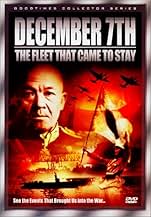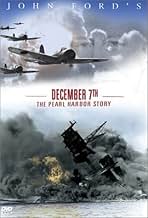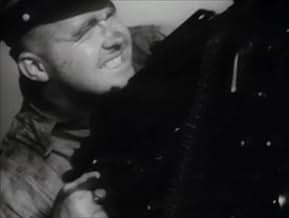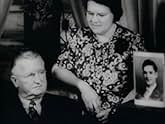"Docudrama" about the bombing of Pearl Harbor on December 7th, 1941 and its results, the recovering of the ships, the improving of defense in Hawaii and the US efforts to beat back the Japan... Read all"Docudrama" about the bombing of Pearl Harbor on December 7th, 1941 and its results, the recovering of the ships, the improving of defense in Hawaii and the US efforts to beat back the Japanese reinforcements."Docudrama" about the bombing of Pearl Harbor on December 7th, 1941 and its results, the recovering of the ships, the improving of defense in Hawaii and the US efforts to beat back the Japanese reinforcements.
- Won 1 Oscar
- 1 win total
- Narrator
- (voice)
- (as James K. McGuiness)
- Shinto Priest
- (uncredited)
- Self
- (uncredited)
- Reporter
- (uncredited)
- Wounded Officer
- (uncredited)
- Self
- (archive footage)
- (uncredited)
- Self
- (uncredited)
- Self
- (uncredited)
- Self
- (uncredited)
- Self
- (uncredited)
- Hawaiian Boy
- (uncredited)
- Pvt. Joseph L. Lockhart
- (uncredited)
- Directors
- Writer
- All cast & crew
- Production, box office & more at IMDbPro
Featured reviews
Toland was a better photographer than a director. Very little documentary footage of the Pearl Harbor attack existed. Most of what was available was shot after the attack, sometimes days later. So Toland organized a lengthy (some 80 minute-long) version of events by restaging the attack both in Hawaii and on the studio lots in Hollywood.
The rather long prologue is like a cartoon. Walter Houston is dressed in an Uncle Sam costume and has a sort of argument with his conscience before the attack. Oh, sure, Uncle Sam admits, there are some traitors among the hyphenated Japanese but they're a negligible threat. We get to hear Philip Ahn (a Korean) explain that Shintoism is Japan, and Japan Shintoism, and that Hirohito is the direct descendant of God, which must have gone over well with Christians.
The attack itself is reasonably well done for the time but embarrassing to watch now. American dive bombers pose as Japanese. The model work, with tiny airplanes on strings, is obvious. Cardboard ships explode into slivers in a tank. Non-actors pose as American servicemen and die Hollywood deaths, twisting and falling gracefully. The narrator tells us that the whole deal might have been different if an inexperienced lieutenant had heeded the radar warning of a subordinate, which is true, but which couldn't be admitted at the time. The result was an unshowable movie.
Ford and his editor, Robert Sherwood, were called in to try salvaging it by cutting it down to about half an hour. Ford may or may not have added any shots. Only one of them resembles something he might have done. (A chaplain saying mass cuts it short, makes the sign of the cross, and says, "To your battle stations, boys.") Of course Ford's name is on the credits as director. He was John Ford. But it isn't his picture.
Uncle Sam is eagerly promoting Hawaii as a peaceful vacation spot. Mr. C questions him and their conversation reveals the history of Japanese immigration onto the island. While Uncle Sam shows them as patriotic Americans, Mr. C counters with suspicions of their true loyalties. Uncle Sam is shown to be naive in his beliefs as Mr. C uses a false story to illustrate the disloyalty of some of the Japanese population cooperating with the Japanese Empire and the German Nazis. Uncle Sam is shown as a weak-kneed disbeliever until the attack wakes him from his sleep proving him wrong. Of all the hokey propaganda takes, the most effective is the voices from the soldiers' graves. It really makes it a war for all Americans.
The fictional espionage story reminds me of the old industrial educational films with bad acting. On the hand, the attack recreations blend very well with real footage of the attack. I can see why so much of it was cut while the leftovers would be award winning. Overall, there is great craftmanship in the battle while the preceding espionage story is poorly acted and problematic as a documentary endeavor. It does show how easily fear can be whipped by against the local Japanese population and explain the popularity of the internment decision. As a time capsule, it shows how a false narrative can easily push people into the wrong conclusions. As a film, it shows great skills in combat recreation.
So, this film set out to wake Americans up and get people to stop to think. It gave us lots of information about Hawaii. Most Americans probably knew of the islands only as a great place to vacation on the beach. How many non-residents knew much about Hawaii or its people at that time? Who knew that 25 percent of the population was of Japanese descent? Or that 122,000 of the 157,000 Japanese then in Hawaii were American citizens? And remember, that was some two decades before Hawaii was to become a state. For that matter, how many people today know much about Hawaii's past up to the start of World War II? I know I had no inkling of much of this data before seeing this film, and then checking some historical references.
This film gives us a broad picture of the Japanese Americans in Hawaii. We see and learn about their businesses, their beliefs, their culture, and their history. The film presents this in a pro and con format between the two main characters. The message seemed clear. Americans should stop to think, and not jump to conclusions. The film should lead viewers to be more open-minded about the Japanese Americans in general. But, also it should help viewers see the need for vigilance by the government because of known Japanese espionage. By this time, we had considerable experiences with the fifth column efforts by Nazi supporters in the eastern U.S. They tried to promote confusion and distrust among the populace and hinder U.S. support for the Allies in the war. Today, we can look at this film and better understand the time, place, moods, fears and concerns of the nation.
My DVD with this film also has some other interesting extras. It has two movie newsreels, a video with interviews when the Ford film was first shown in Japan in 1995, and Frank Capra's 1945 documentary on Japan, "Know Your Enemy."
A cameraman assigned to Honolulu at the time shot the first Universal newsreel of Pearl Harbor. But, its report is quite inaccurate in places. It says that American Army and Navy planes helped repel a fourth wave of attackers. Such guesswork never should have been used by news sources. As we soon learned, the Japanese attack had wiped out the Army airplane force. And, there were no Navy planes because the carriers were out to sea. In another part, a narrator says that the Japanese attack was planned to take place when the carriers were gone. Again, we know that's not true, as the facts later attested. The Japanese planned their attack mainly to knock out U.S. Naval air power as the core of the U.S. naval forces. That would give them a big advantage in the Pacific, and they were surprised to find out that the carriers weren't in port. Later films, such as "Tora, Tora, Tora," give accurate historical accounts of December 7th, including good accounts from the Japanese side.
Finally, the Capra documentary, "Know Your Enemy," was on this DVD. This is an interesting example of a propaganda film. It was produced apparently to show to Americans going to serve in the Pacific in 1945. Some criticize the narrator's tone and derogatory comments in places. I agree. Propaganda should give information truthfully and without racial or cultural slurs. That said, this film gave more interesting – and accurate – information about Japan. Its history, people and culture of the last two centuries before Pearl Harbor would help Americans understand the why and how of Japan's drive for conquest.
One can see some clear similarities between Japan and Germany – in their efforts to arouse the people to support war and conquest. Several news film clips taken in Japan show masses of people being rallied for support of Japan's efforts. The similarity to Nazi Germany is uncanny. One also can see how the nationalistic rallies in this film could lead so many Japanese soldiers to think lowly of other people and be able to treat prisoners, civilians and even women and children so brutally..
Ford's film, "December 7th," is shown in its uncensored and censored parts – noted on the screen as it plays. This is an excellent piece of history in its own right. Anyone interested in World War II, and anyone who wants to know and understand the history of that time better, should see this film. The extras that are on this DVD are also of historical value.
Did you know
- TriviaTurner Classic Movies showed the original uncut "censured" version of this movie on 15 September 2015. During the introduction with Ben Mankiewicz and Mark Harris, one of many reasons why the movie was censored was in 1943 it was considered too racist against the Japanese.
- GoofsShowing the events of the Sunday morning attack, the priest at Mass (at Kaneohe, I believe) announces incorrectly that it is the 1st Sunday of Advent. Actually it was the 2nd Sunday of Advent.
- Quotes
World War I Ghost Soldier: Six will get you twelve that fifteen to twenty years from now they'll be opening up new sectors in here.
- Crazy creditsThe War and Navy Departments, producers of the movie, are credited orally by a narrator.
- Alternate versionsSpecial 50th anniversary edition on video released in 1991 is restored to 82-minute length with subtitles added to Japanese language sequences and a descriptive prologue added. The 1943 version was a completely censored 34-minute version with the full version being banned by the US government for being damaging to morale.
- ConnectionsEdited into Horizons en flammes (1949)
- SoundtracksColumbia, the Gem of the Ocean
Written by David T. Shaw
Arranged by Thomas A. Beckett
Played as background music often
Details
- Runtime
- 1h 22m(82 min)
- Color
- Sound mix
- Aspect ratio
- 1.37 : 1






























